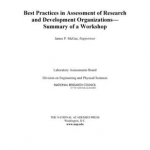Best Practices in Assessment of Research and Development Organizations: Summary of a Workshop
BookThis item doesn’t have any media yet
2012 | Technical
The National Institute of Standards and Technology (NIST)--recognizing that information and insights gained through continual examination of practices for organizational assessment are useful for decision makers at organizations across the deferral, industrial, academic, and national laboratory sectors-recently requested that the National Research Council (NRC) organize a panel to review best practices in assessment of research and development (R&D) organizations. In response, the NRC established the Panel for Review of Best Practices in Assessment of Research and Development Organizations. The panel was charged to consider means of assessing the following in a manner that satisfies the requirements of NIST to perform effective assessments but also identifies assessment methods that can be applied selectively to other R&D organizations.
These methods include: technical merit and quality of the science and engineering work, the adequacy of the resources available to support high-quality work, the effectiveness of the agency's delivery of the services and products required to fulfill its goals, the degree to which the agency's current and planned R&D portfolio supports its mission, as well as the agency's flexibility to respond to changing economic, political, social and technological contexts. As one means of data gathering, among others that the panel is performing toward development of a final report of its findings, the panel organized a planning committee for a workshop on best practices in assessment of R&D organizations. Best Practices in Assessment of Research and Development Organizations: Summary of a Workshop reviews the workshop conducted at the Keck Center of the National Academies in Washington, D.C., on March 19, 2012.
Related Items:
| Published by | National Academies Press |
| Edition | Unknown |
| ISBN | 9780309266161 |
| Language | N/A |
Images And Data Courtesy Of: National Academies Press.
This content (including text, images, videos and other media) is published and used in accordance
with Fair Use.
